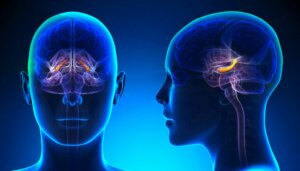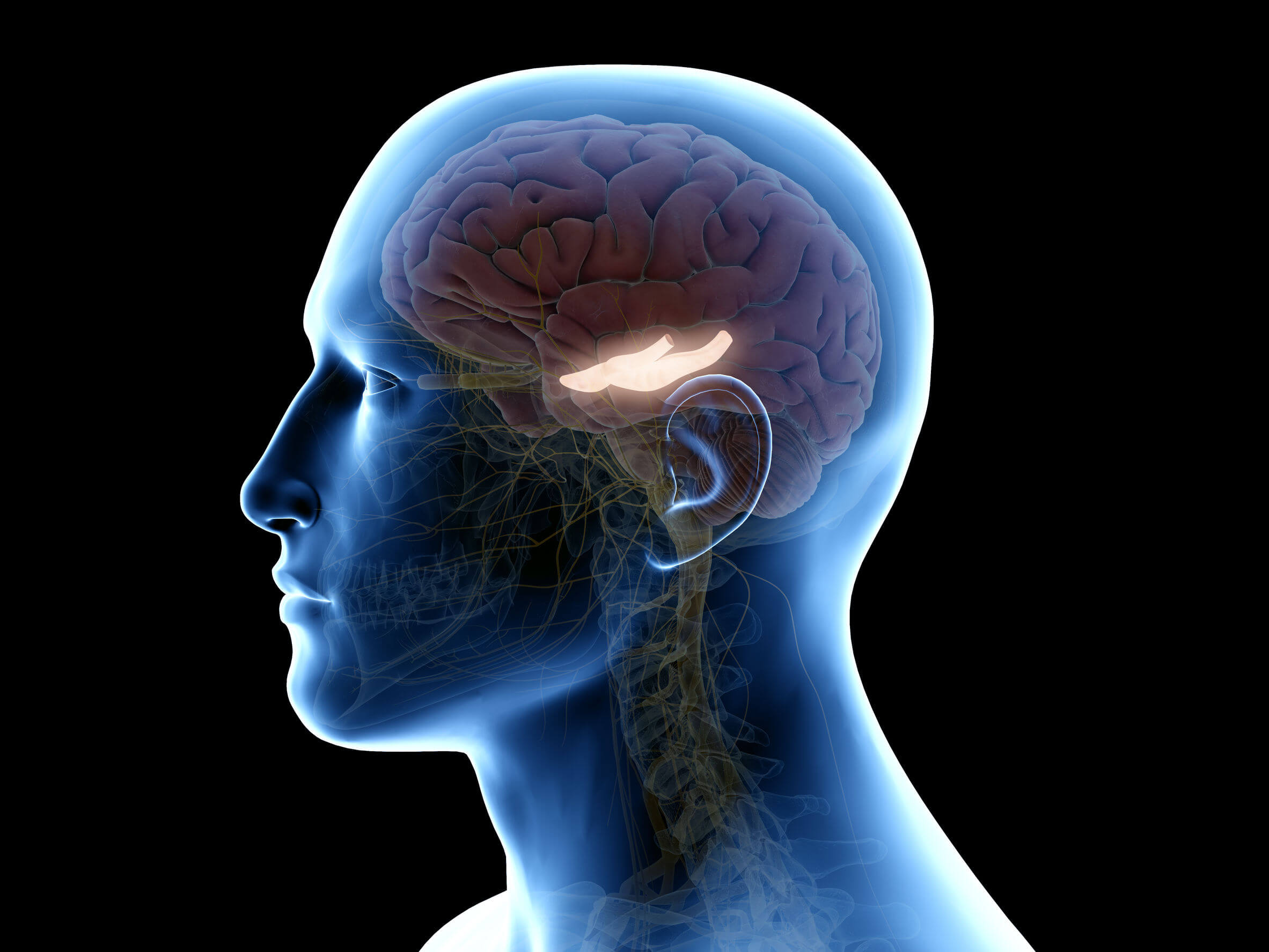What Is the Hippocampus and What Are its Functions?

The brain remains a great mystery in many ways, which is why the development of neuroscience is proceeding so rapidly. The hippocampus, for example, is one of those structures whose study has revealed many vital functions for the human body.
It’s located in the medial temporal lobe, and is part of the limbic system (which is related to emotions, information storage, and motivation). The hippocampus is a very old structure from an evolutionary point of view, and forms part of the archicortex.
It also relates to long-term memory storage, but in what way? What other functions does it fulfill? Is there a relationship between the hippocampus, declarative and non-declarative memory? What happens if the hippocampus is damaged? Discover all the answers below.
“Memory seems great because of what it shows us in its memories, but it’s much more so because of what it certainly hides.”
-Niceto Alcalá Zamora-
The limbic system: hippocampus and amygdala
Before explaining what the hippocampus is and what it’s responsible for, let’s find out where it is exactly in the brain. The hippocampus is part of the limbic system, which is responsible for regulating physiological responses to certain stimuli.
It also participates in the storage of information, in addition to coordinating autonomic and endocrine responses with emotional states. From an anatomical point of view, it includes the hippocampal formation and the amygdala.
Hippocampal and amygdala formation
Both are located in the medial temporal lobe. The amygdala is responsible for assessing the emotional meaning of experiences, as well as coordinating the somatic expression of emotion and conscious feeling.
On the other hand, the hippocampal formation is made up of the hippocampus, the trigone or fornix, the dentate gyrus, the subicular complex, and the entorhinal cortex. Its main function is the long-term enhancement of memory and learning processes.

What is the hippocampus and what are its functions?
The word hippocampus comes from the same word in Latin, which, in turn, comes from the Greek hippos = horse, and kampos = the sea monster Campe (typical of Greek mythology).
It’s one of the most important structures in the brain, both in humans and in other mammals. It was named by Giulio Cesare Aranzio, a 16th-century anatomist, who gave it that name because of its resemblance to the shape of the seahorse.
Activation of memories
The hippocampus is an area of the brain that’s related to the storage of long-term memories; however, its relationship with them isn’t that simple.
In reality, the hippocampus acts as a mediator (or directory) for memories. The activation of memories is associated with the proper functioning of the neural networks distributed throughout the brain.
So, it’s not really the case that the hippocampus “stores” or “contains” memories, but rather that this structure acts as an activation node that allows the different memories that we’re storing to be activated.
That is, memories are “distributed” throughout the brain, but when certain structures and neural networks are activated, such as the hippocampus, then it ensures that we have access to them.
“The hippocampus is a necessary structure for the consolidation of declarative memories – those memories with episodic content about our experiences, or those with semantic content”.
-Nadel and O’Keefe-
Declarative memory
On the other hand, we know that the hippocampus is related to certain types of memory more than others. This is the case with declarative or explicit memory, the one in charge of storing the memories and information that can be consciously evoked (such as childhood memories and the experiences we had on our wedding day).
In contrast, in the case of non-declarative memory (which “contains” memories of movement patterns and motor skills, such as walking or cycling), it’s more regulated by other structures, such as the cerebellum and the basal ganglia.
Perception of space
The hippocampus also intervenes in the way we perceive space (spatial navigation). This refers to the way we interact with and understand the three-dimensional space that we move through. This also includes taking into account the spatial references and volumes.
In this sense, the study of the hippocampus in experiments with mice has shown the existence of neurons (called “place cells”) which play a fundamental role in spatial navigation.
Damage to the hippocampus
If we hit our head hard or suffer brain damage of any kind, and the hippocampus is damaged, then we can suffer anterograde and retrograde amnesia. These types of amnesia appear in the production and evocation of memories related to declarative memory. However, in these cases, non-declarative memory is usually preserved.
Thus, a person with a severe hippocampal injury may not remember many events in his life (declarative memory) but, in contrast, could still continue to learn manual skills (such as dancing), even though later they may not remember having learned the process.
In short, people with damage to the hippocampus can suffer different types of memory disorders, and lose the ability to form and retain new memories.
Alzheimer’s disease and other conditions
On the other hand, Alzheimer’s disease, and other forms of dementia have been shown to affect and damage the hippocampus. This would explain, to a large extent, the memory impairment in these people.
What we do know is that, among the initial symptoms of Alzheimer’s, there’s a loss of short-term memory and the appearance of disorientation. All this is related to the involvement or damage of the hippocampus.
Furthermore, a lesion in this structure is also related to diseases such as epilepsy, schizophrenia, post-traumatic stress disorder (PTSD), and transient global amnesia (TGA).

Hippocampus: the “heart” of the brain?
Research led by Lam Woo, Professor of Biomedical Engineering at the Department of Electrical and Electronic Engineering at the University of Hong Kong, reached the following conclusion: Hippocampal connectivity integrates widely separated brain regions, which play a key role in brain function.
But what do the findings of this study indicate? That the hippocampus could be considered the “heart” of the brain, as it integrates very diverse functions and is located in the “epicenter” of the brain.
This research further demonstrated that low-frequency activities in the hippocampus lead to increased functional brain connectivity in the cerebral cortex.
A therapeutic way to improve memory?
The results found by these researchers suggest that low-frequency activities in this structure (typical of deep sleep) could improve learning and memory.
They also showed that these two processes settle in the brain when we’re immersed in deep sleep. This could be useful in patients with Alzheimer’s or in people with different memory-related pathologies.
The brain remains a great mystery in many ways, which is why the development of neuroscience is proceeding so rapidly. The hippocampus, for example, is one of those structures whose study has revealed many vital functions for the human body.
It’s located in the medial temporal lobe, and is part of the limbic system (which is related to emotions, information storage, and motivation). The hippocampus is a very old structure from an evolutionary point of view, and forms part of the archicortex.
It also relates to long-term memory storage, but in what way? What other functions does it fulfill? Is there a relationship between the hippocampus, declarative and non-declarative memory? What happens if the hippocampus is damaged? Discover all the answers below.
“Memory seems great because of what it shows us in its memories, but it’s much more so because of what it certainly hides.”
-Niceto Alcalá Zamora-
The limbic system: hippocampus and amygdala
Before explaining what the hippocampus is and what it’s responsible for, let’s find out where it is exactly in the brain. The hippocampus is part of the limbic system, which is responsible for regulating physiological responses to certain stimuli.
It also participates in the storage of information, in addition to coordinating autonomic and endocrine responses with emotional states. From an anatomical point of view, it includes the hippocampal formation and the amygdala.
Hippocampal and amygdala formation
Both are located in the medial temporal lobe. The amygdala is responsible for assessing the emotional meaning of experiences, as well as coordinating the somatic expression of emotion and conscious feeling.
On the other hand, the hippocampal formation is made up of the hippocampus, the trigone or fornix, the dentate gyrus, the subicular complex, and the entorhinal cortex. Its main function is the long-term enhancement of memory and learning processes.

What is the hippocampus and what are its functions?
The word hippocampus comes from the same word in Latin, which, in turn, comes from the Greek hippos = horse, and kampos = the sea monster Campe (typical of Greek mythology).
It’s one of the most important structures in the brain, both in humans and in other mammals. It was named by Giulio Cesare Aranzio, a 16th-century anatomist, who gave it that name because of its resemblance to the shape of the seahorse.
Activation of memories
The hippocampus is an area of the brain that’s related to the storage of long-term memories; however, its relationship with them isn’t that simple.
In reality, the hippocampus acts as a mediator (or directory) for memories. The activation of memories is associated with the proper functioning of the neural networks distributed throughout the brain.
So, it’s not really the case that the hippocampus “stores” or “contains” memories, but rather that this structure acts as an activation node that allows the different memories that we’re storing to be activated.
That is, memories are “distributed” throughout the brain, but when certain structures and neural networks are activated, such as the hippocampus, then it ensures that we have access to them.
“The hippocampus is a necessary structure for the consolidation of declarative memories – those memories with episodic content about our experiences, or those with semantic content”.
-Nadel and O’Keefe-
Declarative memory
On the other hand, we know that the hippocampus is related to certain types of memory more than others. This is the case with declarative or explicit memory, the one in charge of storing the memories and information that can be consciously evoked (such as childhood memories and the experiences we had on our wedding day).
In contrast, in the case of non-declarative memory (which “contains” memories of movement patterns and motor skills, such as walking or cycling), it’s more regulated by other structures, such as the cerebellum and the basal ganglia.
Perception of space
The hippocampus also intervenes in the way we perceive space (spatial navigation). This refers to the way we interact with and understand the three-dimensional space that we move through. This also includes taking into account the spatial references and volumes.
In this sense, the study of the hippocampus in experiments with mice has shown the existence of neurons (called “place cells”) which play a fundamental role in spatial navigation.
Damage to the hippocampus
If we hit our head hard or suffer brain damage of any kind, and the hippocampus is damaged, then we can suffer anterograde and retrograde amnesia. These types of amnesia appear in the production and evocation of memories related to declarative memory. However, in these cases, non-declarative memory is usually preserved.
Thus, a person with a severe hippocampal injury may not remember many events in his life (declarative memory) but, in contrast, could still continue to learn manual skills (such as dancing), even though later they may not remember having learned the process.
In short, people with damage to the hippocampus can suffer different types of memory disorders, and lose the ability to form and retain new memories.
Alzheimer’s disease and other conditions
On the other hand, Alzheimer’s disease, and other forms of dementia have been shown to affect and damage the hippocampus. This would explain, to a large extent, the memory impairment in these people.
What we do know is that, among the initial symptoms of Alzheimer’s, there’s a loss of short-term memory and the appearance of disorientation. All this is related to the involvement or damage of the hippocampus.
Furthermore, a lesion in this structure is also related to diseases such as epilepsy, schizophrenia, post-traumatic stress disorder (PTSD), and transient global amnesia (TGA).

Hippocampus: the “heart” of the brain?
Research led by Lam Woo, Professor of Biomedical Engineering at the Department of Electrical and Electronic Engineering at the University of Hong Kong, reached the following conclusion: Hippocampal connectivity integrates widely separated brain regions, which play a key role in brain function.
But what do the findings of this study indicate? That the hippocampus could be considered the “heart” of the brain, as it integrates very diverse functions and is located in the “epicenter” of the brain.
This research further demonstrated that low-frequency activities in the hippocampus lead to increased functional brain connectivity in the cerebral cortex.
A therapeutic way to improve memory?
The results found by these researchers suggest that low-frequency activities in this structure (typical of deep sleep) could improve learning and memory.
They also showed that these two processes settle in the brain when we’re immersed in deep sleep. This could be useful in patients with Alzheimer’s or in people with different memory-related pathologies.
- Afifi, A.K. y Bergman, R.A. (1999) Neuroanatomía funcional. Madrid: McGraw Hill.
- Carlson, N.R. (2002). Fisiología de la conducta. . Barcelona: Ariel.
- Keefe J.O. & Nadel, L. (1978). The hippocampus as a cognitive map. Oxford: Clarendon Press.
- Kolb, B. y Whishaw I.Q. (2002). Cerebro y Conducta. Una introducción. Madrid. McGraw-Hill.
- Russell W. Chan. ‘Low-frequency hippocampal–cortical activity drives brain-wide resting-state functional MRI connectivity’. Proceedings of the National Academy of Sciences of the United States of America.
Este texto se ofrece únicamente con propósitos informativos y no reemplaza la consulta con un profesional. Ante dudas, consulta a tu especialista.







